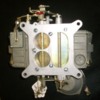Back in the 1960s multiple carburetor induction systems were common place. Six Strombergs, then three Deuces, and finally dual four barrels. It was the era of the wide open induction systems. But by the mid to late 1960s various race sanctioning bodies were adjusting their rules to limit all sorts of racing classes to the use of only one four barrel carburetor.
Holley introduced the list 3916 carburetor in the mid-1960s which stretched the air flow limits of the 4150/4160 size carburetor to 950 cfm for Chrysler's new 426 Hemi NASCAR motor. The new 950 cfm carburetor was a THREE barrel carburetor; it was equipped with a single, oval shaped, secondary butterfly. Holley designated it a 3160 series carburetor. Before the introduction of the 4500 series "Dominator" carburetors in 1970, the list 3916 three barrel carburetor was the biggest single four barrel carb you could buy, and it became quite popular in drag racing. Intake manifold plenum dividers required a notch in order for the oval butterfly to be capable of swinging open. That's why the automakers and the aftermarket began selling their dual plane, single four barrel, performance intake manifolds with notches in the plenum dividers. That small notch was not large enough to affect the performance of the manifold, that was not the original purpose of the notch.
Attachments
Original Post


